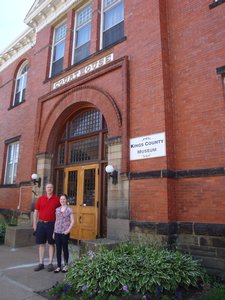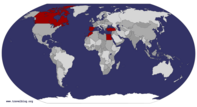Advertisement
Published: November 28th 2010

 King's County Museum & Archives
King's County Museum & Archives
First stop in Kentville to trace Planter roots.Planting our Feet in Nova Scotia
Who knew when we planned our trip to Nova Scotia that we would be part of the Planter 2010 Celebrations that mark the 250th Anniversary of the arrival of the New England Planters, from which Papa Canuck is a descendent?
Nova Scotia’s long and interesting history of the English and French colonizing the province is legendary. The decedents of the French colonists, the Acadians, populated the Northern and Eastern shores of Nova Scotia. When the Acadians were expelled from Nova Scotia in the Great Expulsion of the 1750s, the New England Planters were granted rich, dyked farmlands left vacant. In the early 1760s, the Planters brought with them the colonial pattern of land division, their 'puritan' way of life, their social institutions as well as packing up their homes and livestock to rebuild their homes and lives once they arrived by boat on the shores of the Bay of Fundy.
It was in 1756 that Papa Canuck's ancestors settled in Cornwallis Township situated in the Annapolis Valley, after emigrating from Connecticut where their British-born ancestors settled in the 1630's.
A generation after the Planters, there was a second migration, the

 Cairn at Starr's Point
Cairn at Starr's Point
Commemorative monument to the New England Planters of Cornwallis.United Empire Loyalists who escaped the Revolutionary War in the New England States. Sadly, the United Empire Loyalists out-numbered the 8,000 New England Planters and their descendants as they populated the towns such as Kentville, Kingsport and Canning where Papa Canuck's ancestors first settled.
King's County Museum
We started tracing our Planter roots at the King's County Museum in Kentville, located in the former King's County Courthouse. We spent hours in the museum and archives gathering historical and genealogical information. The museum featured a fascinating and powerful documentary on the New England Planters, part of a Parks Canada National Commemorative Exhibit titled “Planter Generations: The Cultural Legacy” featuring artifacts and documents from the Planters of Horton, Cornwallis and Aylesford Townships. We only wish we could get our hands on a copy of the documentary for our own video library. The search continues!
After leaving the museum, we spent the better part of a day driving the country roads visiting ancestral homes and New England Planter landmarks, including Horton’s Landing, site of the deportation of the Acadians in 1755 and the landing of the Horton Township Planters. We stopped at the Planters Cairn Town Plot located on the
Town Plot Loop Road situated at Starr’s Point commemorating The New England Planters of Cornwallis Township. We visited graveyards and spotted ancestral graves, pinpointed the grants of land to ancestors based on prior research and Google maps, and searched for ancestral homes that dotted the pastoral landscape.
We also toured the picturesque Prescott House Museum and Gardens located at Starr's Point. Charles Prescott’s “Acacia Grove” is an elegant Georgian home that was built in 1812 and refurbished to its former glory in the 1930s with family portraits, antique furnishings and Miss Prescott’s collections of hand-stitched samplers and tribal Oriental carpets. The museum’s knowledgeable interpreter brought the history of the home and the Prescott family to life. It was fascinating to learn how the horticulturalist, Charles Prescott, cultivated Nova Scotia’s apple industry in the Annapolis Valley from 1811 to 1859.
We also stopped by St. John’s Church located in Cornwallis. St. John’s parish was marking its 250th anniversary and the 200th anniversary of the current church building. Unfortunately, the doors were locked as we found was the norm as we toured around Nova Scotia. We were told that it was not that many years ago that all the church

 Jaw Bone Cemetary
Jaw Bone Cemetary
Ancestors abound in the ground!doors were left open to visitors - a sad commentary on life today, even in rural Canada.
After stretching our legs in Canning, we drove to the Lookoff. At 200metres above the Minas Basin, we enjoyed a bird’s eye view of the patchwork of farms, rows of fruit trees and scenic farmhouses that dot the emerald green farmlands that contrast the rusty receding waters of the Bay of Fundy. What a spectacular sight! We then drove down to the water's edge to dip our feet in the Minas Basin after knocking off our shoes and socks. We walked along the red rocky beach hugging the rusty overhanging cliffs while keeping sight of the tides that are the highest in the world to make sure we were not caught by surprise. After all, we were visiting the shores of the Bay of Fundy when the highest tides occur, July 4, 2010.
Checkout our blog called
Trailing Around Nova Scotia's North Shore for an account of the Travelling Canucks adventures along The Glooscap and Evangeline Trails. Find out about our tips and picks for staying and eating in Wolfville and Annapolis Royal and what to do and see in the surrounding areas!
Deep Nova Scotian

 View from Lookoff
View from Lookoff
Beauty of the Minas BasinRoots
As we toured around Nova Scotia for two weeks by car, we searched for known ancestral roots in Pugwash, Yarmouth and Lockeport as well as in the Annapolis Valley.
Pugwash was in fact our first stop on the trail of tracing Papa Canuck's Nova Scotian ancestry. Enroute to Prince Edward Island on June 29th, we departed Halifax in the early morning and took a detour to Pugwash, which is one of the sleepy villages along the Sunshine Trail. Besides Pugwash being renowned for the Pugwash Peace Conference of 1957, it wouldn't be worth the detour unless you happen to have a family connection. Having said that, we were thrilled to discover a small, colourful cafe called Chatterbox Cafe, featuring fair trade coffee, homemade soups, sandwiches, and baked goods. We enjoyed their friendly staff, warm atmosphere, delicious snacks and browsing in the gift shop. We also stopped by the Seagull Pewter Store on our way out of town where the park and school were named after one of our more famous relatives! The Travelling Canucks have never seen so much pewter in one place. Mama Canuck just had to buy a pewter Christmas ornament, a vacation tradition!
After spending six nights in the Annapolis Valley, we drove along the French Shore and stopped in Yarmouth for a short visit where we were impressed by the fine Victorian homes that adorned the streets and enjoyed lunch at Rudder's Brew Pub when the fog lifted and the sun shone down on the outdoor deck. Located in a former church, the Yarmouth County Museum, consisting of five period rooms that were worth the price of admission, was also home to the City Archives, where we unsuccessfully searched for family genealogical information. Unfortunately, we didn't get a chance to see Yarmouth Light at the end of Cape Forchu because of heavy fog that plagued our drive from Annapolis Royal to Lunenburg that day.
Fortunately, our trip to Lockeport on the South Shore of Nova Scotia proved most interesting despite the marine fog that enveloped the shore intermittently. In 1762, two families left Massachusetts to establish a new colony closer to the rich fishing grounds of the Grand Banks. The colony was called Locke’s Island, after Jonathan Locke the patriarch of one of the two families, until the area was incorporated in 1907 and became known as Lockeport. Accidentally, we
met up with one of Jonathan Locke’s ancestors and long lost relative of Papa Canuck. He kindly opened his home and shared his passion for our shared family history. We walked the heritage streetscape commemorated by a monument titled: 'Locke Family Homestead Streetscape' and toured graveyards where ancestors were buried. The sand on Colonel Locke Beach was soft as silk as we stood trying to spot Lockeport’s Lighthouse that could barely be seen through the heavy fog when we first set foot in Lockeport.
It was a collection of dangerous ledges and rocks, known as the Ragged Islands that guard the entrance to Lockeport Harbour that precipitated the building of the lighthouse atop Gull Rock. Although the original lighthouse was completed in 1853, the present lighthouse was built around 1955 and features a square tower mounted on the pyramidal roof of a two-story dwelling, which we finally saw after the fog lifted momentarily. Another claim to fame is Crescent Beach. Its image once graced the back of the Canadian $50 banknote issued in 1954.
Papa Canuck was thrilled that he was able to share his family's Nova Scotian roots that run deep in Pugwash, the Annapolis Valley, Yarmouth 
 Locke Homestead
Locke Homestead
Long lost relative chance meeting!and Lockeport with Canuck Junior. A privilege he had not shared with his father and grandfather, although they had once hoped to do so.
Lesson Learned: Take the time to share your family's heritage with your children so that they may also share it with theirs. Otherwise, our connections to our past may be lost and future generations may not have their feet firmly planted in knowing where they came from. Guess that means that the Travelling Canucks will be heading to Quebec and Scotland to explore the maternal ancestry in the years to come!
Advertisement
Tot: 0.095s; Tpl: 0.012s; cc: 12; qc: 26; dbt: 0.0479s; 1; m:domysql w:travelblog (10.17.0.13); sld: 1;
; mem: 1.1mb






















